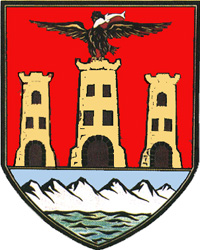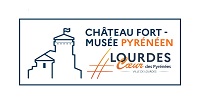The legend of Charlemagne

|
"A shield gules with three golden towers built of sand on a silver rock; the middle one being higher, surmounted by an eagle of sand with its wings spread and with golden feet, holding in its beak a silver trout tipped with blue, and six silver mountains washed by a natural river". |
A legend thought to have originated from a 13th century text by an English chronicler, Friar Marfin, has left its mark on the Lourdes coat of arms.
The story may go as follows :
In the year 778, Charlemagne, king of the Franks, was returning from Spain to fight the Saracens. He stopped at Lourdes to recapture the castle of Mirambel, occupied by a Moorish chief, Mirat.
 Mirat was ordered many times to surrender, but, despite the privations borne heroically by himself and the men in his garrison, he refused to surrender to a mortal.
Mirat was ordered many times to surrender, but, despite the privations borne heroically by himself and the men in his garrison, he refused to surrender to a mortal.
Charlemagne’s troops began to tire of such a long siege. The king himself was thinking of lifting the siege when an unusual occurrence hastened the event.
An eagle, which had just captured a large fish, dropped its prey at the Moorish chief’s feet. The cunning Mirat grabbed the fish and threw it at Charlemagne’s soldiers, saying: "I’ve twenty thousand more like that in the castle cistern".
Turpin, the bishop of Puy-en-Velay, who was travelling with Charlemagne, realised that this was a hoax and decided to negotiate with Mirat. He said: "As you will not surrender to King Charles who is the most illustrious of mortals, then surrender to the most noble Lady who ever was, the mother of God, Our Lady of the Puy.
I am her servant : become her knight".
At these words, Mirat, touched by grace and surely starving, replied: "I surrender my arms and give myself up with everything I own to the mother of God, Our Lady of the Puy, and consent in her honour to make myself a Christian. But as I intend to commit myself freely, I want the land of Bigorre to belong to her alone, for me and for my descendants".
Mirat was baptised and took the Christian name of Lorus. The castle of Mirambel was then named after Lorus, and this is said to be how the town of Lourdes got its name.
















